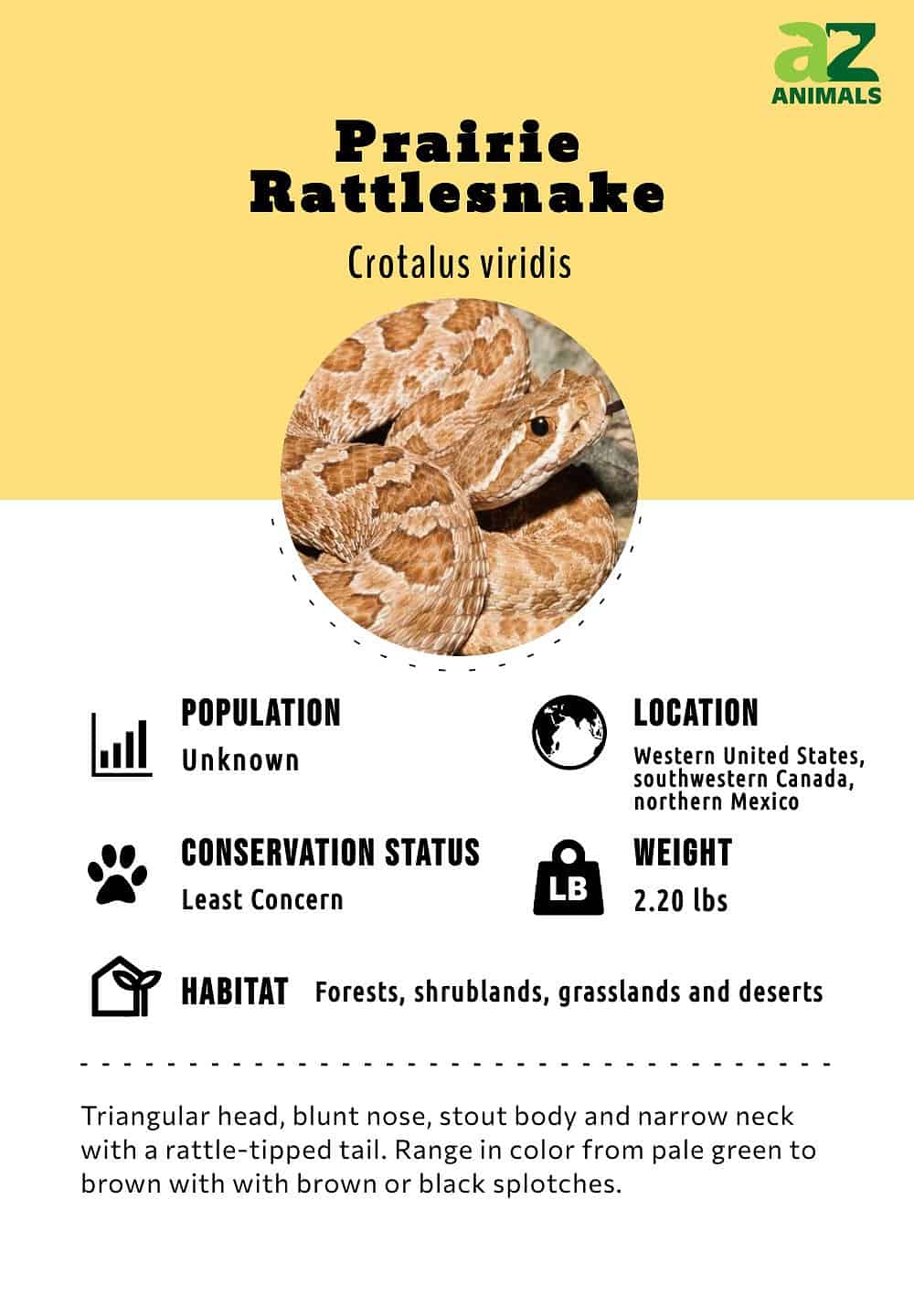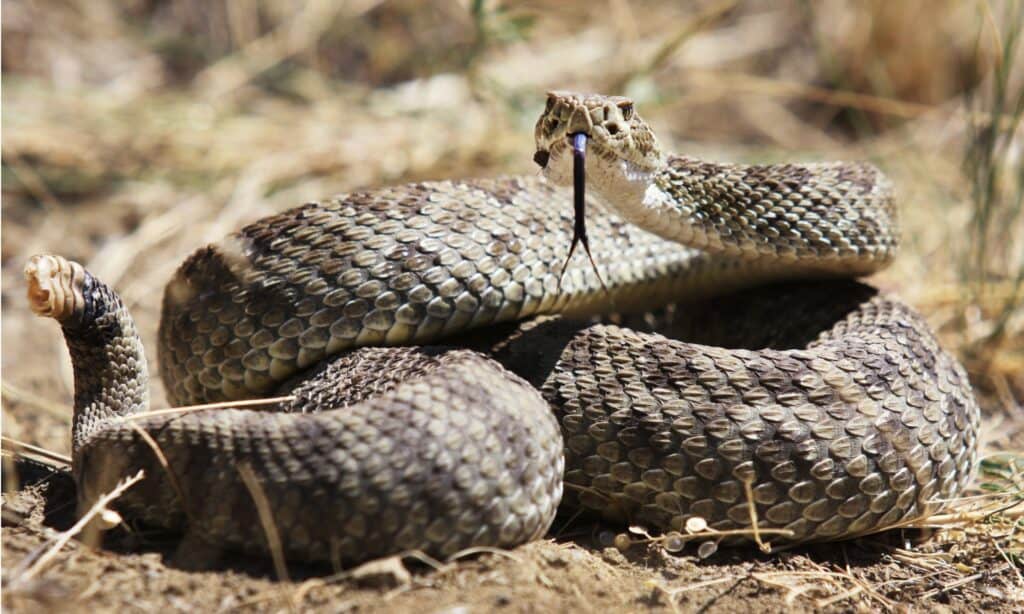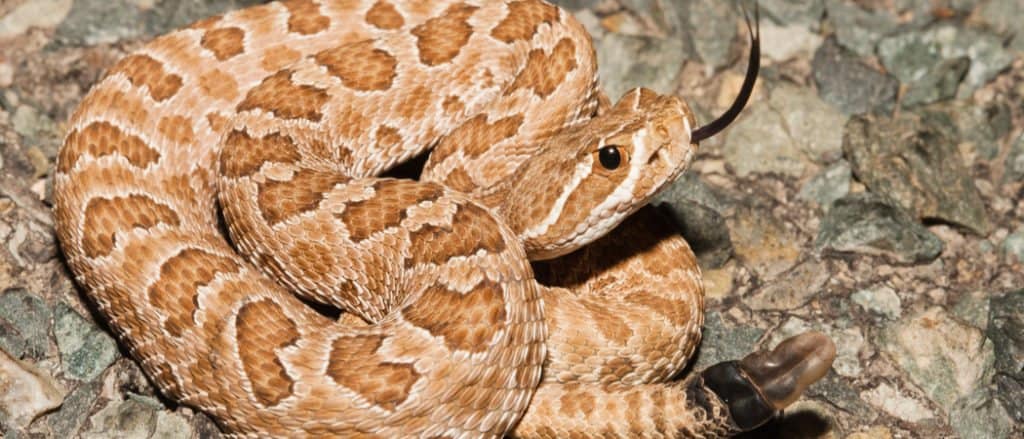Prairie Rattlesnake
Crotalus viridis
The striking distance of a prairie rattlesnake is 2/3rds the length of its body.
Advertisement
Prairie Rattlesnake Facts
- Prey
- mice, rats, rabbits, birds, prairie dogs
- Name Of Young
- hatchling
- Group Behavior
- Solitary
- Fun Fact
- The striking distance of a prairie rattlesnake is 2/3rds the length of its body.
- Estimated Population Size
- 100,000
- Biggest Threat
- habitat loss and intentional persecution
- Most Distinctive Feature
- tail rattle
- Other Name(s)
- Western rattlesnake, Great Plains rattlesnake
- Gestation Period
- 3-4 months
- Litter Size
- 25
- Habitat
- grasslands, plains, foothills, and mountains
- Average Litter Size
- 25
- Lifestyle
- Solitary
- Common Name
- Prairie rattlesnake
- Origin
- Western United States
- Number Of Species
- 32
View all of the Prairie Rattlesnake images!
Prairie rattlesnakes may be dangerous, but they are not aggressive and will not attack humans unless provoked.
The prairie rattlesnake is one of the most famous and well-recognized types of pit viper in the world. These snakes like to live in arid and grassy environments and are found all throughout the central United States.
Although they do not typically pose a threat to humans, prairie rattlesnakes are incredibly venomous and should be avoided for safety. However, as long as you respect their boundaries, prairie rattlesnakes are a welcome and harmless part of the local ecosystem.
Incredible Prairie Rattlesnake Facts
- Rattlesnakes aren’t born with their rattles. Instead, they have a tiny nub at the end of their tail, and they grow another link every time they shed their skin. After shedding 2-3 times, the snake is capable of making a rattling sound.
- Some rattlesnake species have incredibly high venom toxicity and are capable of delivering a bite that can kill humans and other large mammals.
- Female rattlesnakes don’t lay eggs. Instead, the eggs hatch while still inside the female’s body, and she gives birth to live hatchlings.
- Prairie rattlesnakes don’t have great eyesight. Instead, they hunt using their exceptional smell and movement senses.

Evolution And History

Each rattlesnake’s venom is slightly different.
©iStock.com/Matt Kaminski
The rattlesnakes of today evolved around 12 to 14 million years ago, from an ancestor that had incredible genes that made venom that would target all areas – the blood, the nervous system, and the muscles. During evolution, the rattlesnake quickly erased certain genes that produced a wide variety of toxins and focused on one area, which produced a faster evolution and now gives the snake specialized venom. Each different species of rattlesnake will have a distinctive alteration in its venom.
Scientific Name
The scientific name of the prairie rattlesnake is Crotalus viridis. The name “Crotalus” comes from the Greek word for “rattle” and likely refers to the distinctive rattle at the end of each rattlesnake’s tail. The word “viridus” come from the Latin word for something that is green, vibrant, and alive.
Although there were once many different recognized subspecies of Crotalus viridis, since 2001 they have been condensed into two. Crotalus viridis, which can be found east of the Rocky Mountains, now includes the conventional species known as Crotalus viridis viridis (prairie rattlesnake) and the Hopi rattlesnake (Crotalus viridis nuntius). Meanwhile, recognized subspecies found west of the Rocky Mountains is now called the Northern Pacific rattlesnake (Crotalus oreganus).
Appearance And Behavior

Prairie rattlesnakes are also called western rattlesnakes.
©iStock.com/HRossD
Prairie rattlesnakes are rather large snakes that often grow to be three feet or longer. The largest ever recorded prairie rattlesnake was 4.97 feet long. Prairie rattlesnakes are usually light brown in color with darker brown patches that are often bordered in either tan or white. This species can be recognized immediately by its thin neck, triangle-shaped head, and distinctive tail rattle. This rattle is made out of bony segments that clatter against each other when the tail is flicked back and forth. Rattlesnakes often use this sound as a warning, although they do not always necessarily rattle before they strike.
Rattlesnakes are a mostly solitary species, although it’s not uncommon to find multiple snakes basking in the same location. Most rattlesnakes stay within the boundaries of their home range; however, because they are not territorial, they will often share this range with other snakes, especially if there are enough food resources.
Read about the largest prairie rattlesnake ever recorded.
Prairie Rattlesnake Vs Western Diamondback
Prairie rattlesnakes and western diamondback rattlesnakes are incredibly similar subspecies that can be difficult to tell apart. First, it’s important to recognize that the western diamondback is usually found in either the southern United States or northern Mexico. Western diamondbacks typically have larger patches, flatter faces, and an even ratio of black and white stripes on their tail near the rattle. In contrast, prairie rattlesnakes are thinner and longer, and the ratio of white to black on their tails is 2:1. These identifying features are not consistent enough to be considered facts, but experienced snake handlers often have no problem telling the difference between the two.
Habitat
Prairie rattlesnakes can be found across the United States in plains, foothills, and other arid environments to the east of the Rocky Mountains. These snakes crawl through the grass to hunt, bask on sunny rocks, and live in unoccupied prairie dog burrows and other small crevices. You can also find prairie rattlesnakes in wooded areas that are capable of providing plenty of food, sunshine, and places to hide.
In general, prairie rattlesnakes are active during the mornings and evenings. These snakes are largely diurnal but switch to more nocturnal behaviors when the heat of summer arrives. It’s not abnormal to find prairie rattlers hiding in shadowy areas underneath porches or rocks, especially if the weather is particularly hot or humid.
Prairie rattlesnakes hibernate during the winter. Interestingly, the same snake will often return to the same home den year after year. Upon waking in the spring, the rattlesnake will migrate back to a nearby hunting territory and decide on a home range to spend their time in.
Predators And Threats

The prairie rattlesnake will strike its prey before retreating and waiting for the prey to die before eating it.
©Harris Motion Photo/Shutterstock.com
Prairie rattlesnakes only eat when they are hungry. Younger rattlesnakes need to eat once a week, while adult rattlers often go as much as two weeks between meals. When it’s time for food, the hungry rattlesnake will hunt until it finds a small animal such as a mouse, rat, rabbit, bird, or prairie dog. Then, the rattlesnake strikes the prey with a venomous bite before retreating and following from a safe distance. Once the prey dies from venom toxicity, the rattlesnake will appear and eat it.
All small animals are in danger of being prey to prairie rattlesnakes. Whey can’t find a mammal, rattlesnakes have also been known to hunt birds, amphibians, and even other reptiles. The rattlesnake’s venom effects are so dangerous that most large prey animals also avoid them. It’s smart to keep dogs, cats, and other large pets away from areas where prairie rattlesnakes might be present.
However, as dangerous and talented as these snakes might be, they are also susceptible to their own natural predators. In particular, prairie rattlesnakes need to watch out for hawks, owls, and other birds of prey. Foxes, coyotes, skunks, bobcats, and other predatory mammals have also been known to catch rattlesnakes for an occasional meal.
Prairie rattlesnakes are incredibly resourceful and don’t usually have a problem maintaining their population numbers. The current biggest threats to the rattlesnake’s existence are habitat reduction and intentional hunting by local humans. Before attempting to exterminate the rattlesnakes on your land, contact a local park ranger to see if there are any regulations or population concerns.
Reproduction, Babies, And Lifespan

Females usually give birth to between 4 and 25 babies at a single time.
©Nathan A Shepard/Shutterstock.com
Prairie rattlesnakes don’t reach sexual maturity until they are at least 4 years old. Mating season occurs once a year during the spring. Although it’s suspected that males attempt to mate every year, females only seek out mating once every 2-3 years. After mating, the females will retreat to a communal den, where they will usually give birth sometime in late August.
Prairie rattlesnakes deliver live young instead of eggs. One female will usually give birth to between 4 and 25 baby snakes at a single time. Baby snakes are capable of caring for themselves, but they will usually stay in the communal den until they grow large enough to feel crowded and starved for resources.
When born, baby rattlesnakes are between 22 to 28 centimeters long. Young snakes have full fangs with normal venom effects, making them unsafe for handling by anyone other than an experienced professional. Interestingly, baby rattlesnakes do not have rattles, but instead, have a tiny nub at the end of their tail. A new nub will be added every time the snake sheds its skin; most snakes can rattle after shedding about 2-3 times.
Prairie rattlesnakes grow quickly during their first year and can often double in size. Once they mature into adults, their growth rate slows to a rate of about 3-5 centimeters a year. Unfortunately, due to their small size and strong competition for resources, most young rattlesnakes don’t make it past their first year of growth and are instead carried off by birds or other predators. However, if they survive into old age, prairie rattlesnakes can oven live to be as old as 25 years of age.
Population
Prairie rattlesnakes are incredibly common throughout the central United States and across the Great Plains. Currently, no population estimates are available. However, frequent enough sightings have allowed this animal to be labeled as of least concern.
Similar Animals
View all 192 animals that start with PPrairie Rattlesnake FAQs (Frequently Asked Questions)
Are prairie rattlesnakes carnivores, herbivores, or omnivores?
Prairie rattlesnakes are carnivorous and eat prey such as prairie dogs, rabbits, mice, and other small mammals. Like other pit vipers, rattlesnakes kill their prey with venom toxicity and eat the animal after it is dead.
How poisonous is a prairie rattlesnake?
Although they are not poisonous, prairie rattlesnakes are incredibly venomous. A bite from a prairie rattlesnake can cause serious pain and may even be lethal to an adult human. If you get bitten by a rattlesnake, seek medical treatment as soon as possible. Do not allow these creatures near dogs, small children, or any other animal that might not be large enough to survive a bite.
Where is the prairie rattlesnake found?
Prairie rattlesnakes are a type of pit viper that can be found on the Great Plains and in other arid environments throughout the United States. You can usually find these snakes hiding in abandoned burrows, sleeping on or under large rocks, and generally lurking in grasslands or small wooded areas.
What do you do if a prairie rattlesnake bites you?
Call 911 as soon as the snake bite occurs. The victim should stop moving and make sure that the wound is not raised above heart level, as this will make the venom effects take hold more quickly. Let the wound bleed to release some of the toxicity, but be sure not to wash the wound off; the medical team may need the venom on your skin to identify the correct antivenin. Be sure to remove any constricting clothing, jewelry, or bandages before the wound starts to swell.
Are prairie rattlesnakes protected?
Most species of rattlesnake are not listed as endangered or protected, including the prairie rattlesnake. Anyone can kill a rattlesnake as a method of self defense. However, it’s not advised to hunt these snakes without a license or kill them for any other purpose than ending an immediate threat to human life.
Thank you for reading! Have some feedback for us? Contact the AZ Animals editorial team.
Sources
- Active Wild, Available here: https://www.activewild.com/prairie-rattlesnake-facts/
- Animalia, Available here: https://animalia.bio/prairie-rattlesnake
- Nature, Available here: https://www.nature.org/en-us/get-involved/how-to-help/animals-we-protect/prairie-rattlesnake/
- Lubbock Online, Available here: https://www.lubbockonline.com/article/20140502/NEWS/305029763
- Wikipedia, Available here: https://en.wikipedia.org/wiki/Crotalus_viridis
- NCBI, Available here: https://www.ncbi.nlm.nih.gov/pmc/articles/PMC5234031/
- NPS, Available here: https://www.nps.gov/articles/000/prairie-rattlesnakes-badl.htm

















